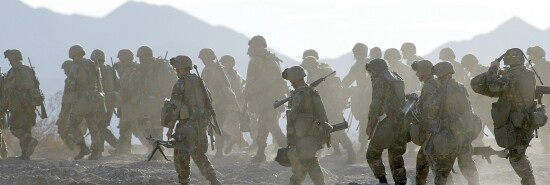
What were they thinking when they chose to invade Iraq?
Dan Hannan
Video Embed
Twenty years ago, the U.S. set in motion the most disastrous foreign policy blunder in its history. On March 19, 2003, 160,000 American and British troops, accompanied by auxiliary detachments from Australia and Poland, invaded Iraq.
Their immediate aim was to overthrow Saddam Hussein. In that, at least, they succeeded. The fighting was largely over in three weeks. Baghdad was occupied, Saddam fled, and, on May 1, President George W. Bush declared “mission accomplished.” Though we moan about our decline, the Anglosphere in arms remains an awesome force.
What happened next was a different story. Whether we measure the financial cost, the civilian casualties, or the strategic consequences, the occupation was catastrophic — worse, even, than Putin’s invasion of Ukraine, which in some ways it inspired.
How did liberal democracies, led by well-meaning representatives guided by eminent academics and foreign policy specialists, end up inflicting such a calamity on the human race? The invasion triggered a monstrous civil war, with all the attendant horrors: malnutrition, sexual assault, exile. Some 4.4 million Iraqis became refugees, and, according to a Lancet study, 601,000 lost their lives.
The photograph that defined the war, every bit as paradigmatic as the man standing in front of the tank in Tiananmen Square in 1989, was that of Ali Shallal al Qaisi at Abu Ghraib prison, his head covered with a black hood, his outstretched hands attached to electrodes. How many terrorists were inspired by that image? How many jihadi militias grew up in the chaos that followed the removal of the Ba’athist tyranny? One of them turned into ISIS. A war launched intended to drain the swamp where the insects hatched instead ended up incubating the most bloodthirsty and territorially successful terrorist movement since Bolshevism.
Even viewed in purely neoconservative terms, the war was a fiasco. It removed an anti-Iranian regime from the mullahs’ doorstep, thereby inviting more adventurism from ayatollahs who really did specialize in exporting violence. It made a dangerous region vastly more dangerous. It destroyed American prestige. It cost, according to Brown University, $1.7 trillion — cash that would have been handy during the pandemic. Oh, and there turned out to be no weapons of mass destruction.
The trouble was that the war was launched on a falsehood. It was never about hidden nuclear weapons. On the eve of the invasion, the IAEA reported that it had “found no evidence or plausible indication of the revival of a nuclear weapons program in Iraq.” Nor was it about 9/11. Claims by U.S. intelligence of a link between Saddam’s secular regime and al Qaeda were pure fabrication.
The trouble was that supporters of the war never came clean about their motives. Their intention was honorable, if naive. In a region that had long been a headache for the U.S., they intended to take the most troublesome state and reform it. Instead of Iraq spewing out its problems across the world — at Kuwait, at Israel, at the West — it would be reformed into a model of good government and exert a benign pull on its neighbors.
None of this constituted a casus belli, either morally or legally. But the Twin Towers abomination created such a wave of revulsion that the interventionists spotted their moment, alleged a link, cooked up some nonsense about secret weapons programs, and attacked.
Why didn’t their nation-building work? In retrospect, it seems obvious. Iraq, like much of the non-Western world, was a clan-based society. It had the outward trappings of statehood — courts, a parliament, and so on — but everything worked on the basis of tribe. One group happened to be on top — Sunni Arabs generally, and Saddam’s Tikriti clan particularly — and it had imposed some kind of stability at huge cost to the Shiites and, even more, the Kurds. Resentments and sectarian feuds festered. There were scores to settle. Twenty years on, Iraq’s politics revolve around street protests, the storming of buildings, political arrests, assassinations, and armed militias.
In 2003, it felt as if the tide was running with the West. More and more countries were turning toward freedom and the rule of law. Today, the tide has turned. Every organization that measures the spread of democracy — Freedom House, the Democracy Index, International IDEA, the Economist Intelligence Unit — tells the same story, namely that seven decades of liberal advance came to a halt at some point after 2010 and started to go into reverse. The question is not whether we can impose our system of government on others; it is whether we can retain it ourselves.
